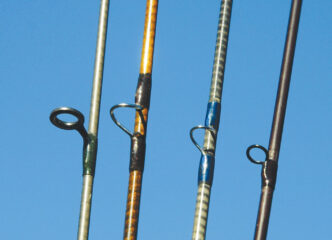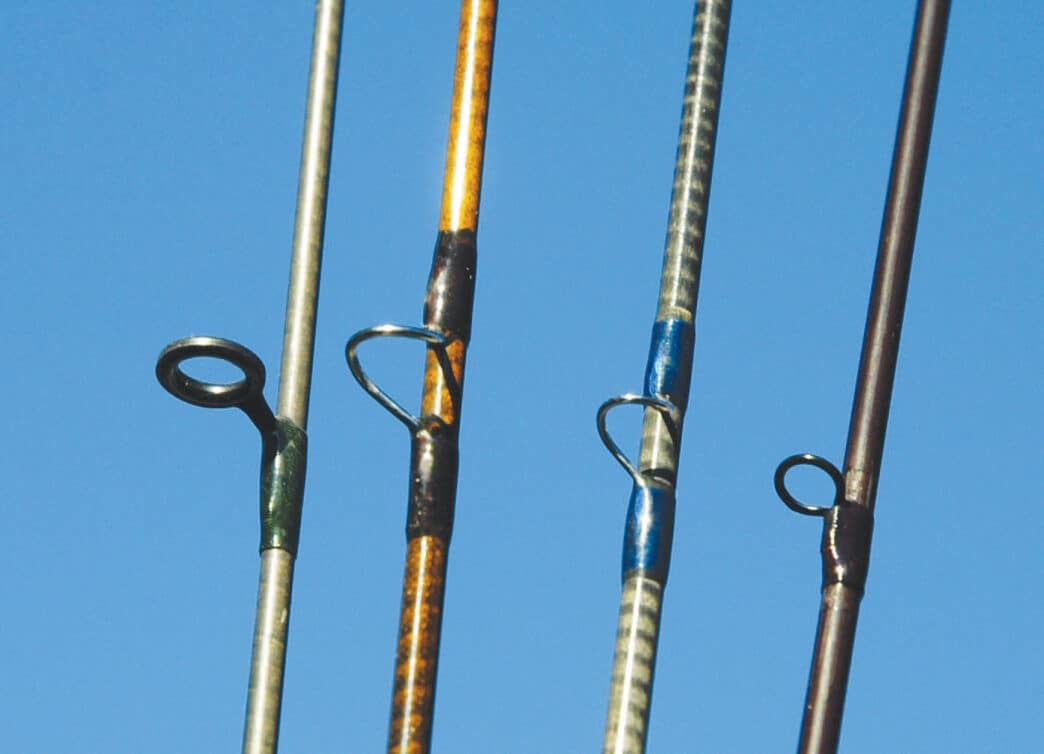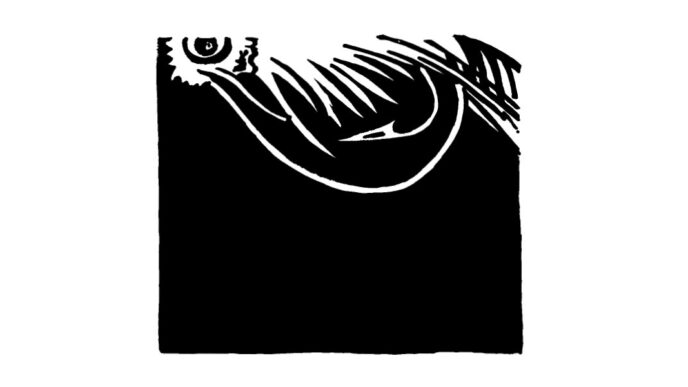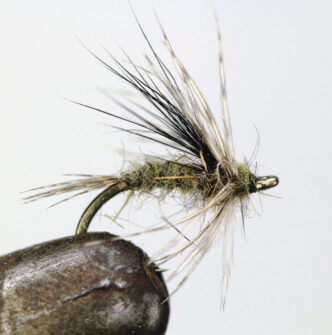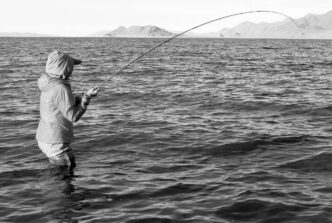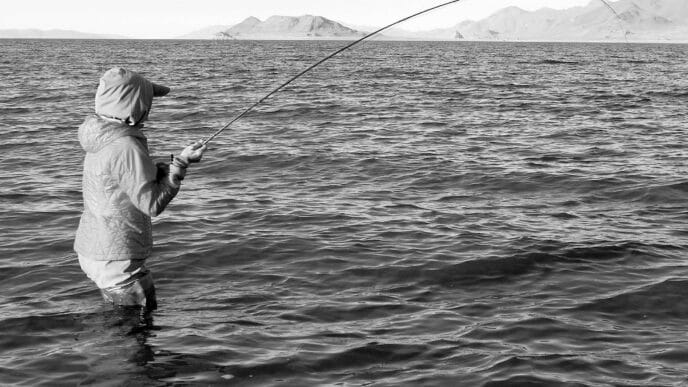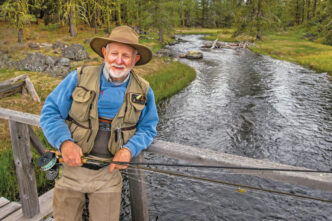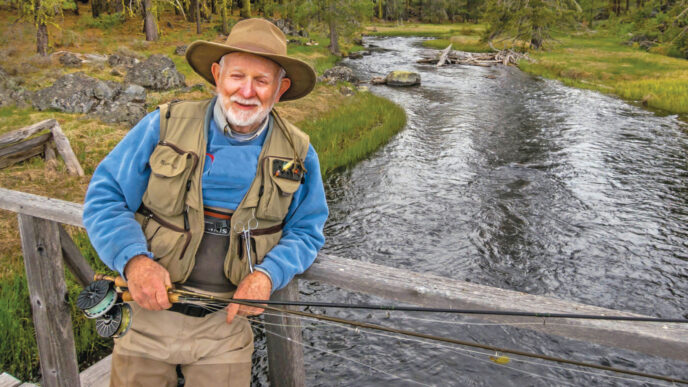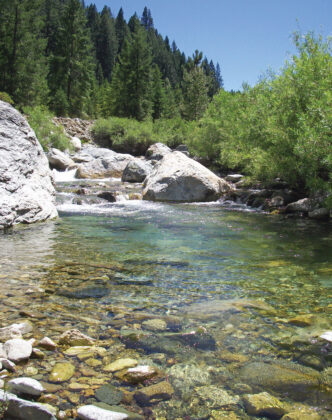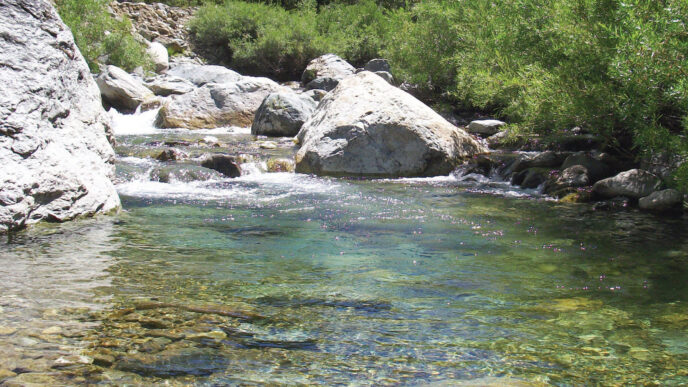There is a special kind of frustration that eats into your psyche when your best casts fall short. It happens on all kinds of waters, when targeting all kinds of fish. There is the chronic irritation we all get when average-size fish are feeding just out of range. We may mutter a bit, but feel no need to utter unholy oaths or resort to ethanol-based liquids. That’s just fishing, and we take it in stride.
The problem becomes more acute when the fish in question are a bit larger than average. That’s when our behavior becomes more excitable, and we are prone to rather “sporty” utterances. The same thing happens when the wind comes up, and our casts stall out or crash to the water before the fly reaches happily feeding fish. And things really go downhill when the fish are more than just large, they are huge. When faced with unreachable finned behemoths, many anglers meltdown so spectacularly you’d swear they were auditioning for a David Lynch movie.
This is when most of us go looking for the simple or quick fix, instead of working on our casts. I guess this is natural and in some ways quite logical. Why bother learning to cast farther when you may be able to add feet or yards to your cast with some specialized equipment? The fly-fishing world is full of people only too happy to sell us stuff that claims to do just that. The question is, does it really work?
The desire to connect with distant fish has driven me to spend a considerable amount of discretionary time and money figuring out what truly adds distance. Most of my efforts were applied to my casting skills, since this is how you really add yards to your casts. But like anyone else, I was also looking for equipment that would help me put my fly out a bit farther. While advances in design and materials have resulted in fly lines that cast farther, most people look to the fly rod for those precious extra feet. What follows is a distillation of the many hours I have spent analyzing rods and their components. My findings are all based on countless casts measured against the tape and crunched by a calculator or spreadsheet. That’s not as much fun as fishing, perhaps, but the rewards have quite literally been measured in feet and pounds.
Line Speed and Rod Action
In order to cast far, you need to generate high line speed. This is as true for a ticklish little 2-weight small-stream rod as it is for a torque wrench 10-weight striper stick. Research conducted by a number of folks with fancy degrees, high-speed cameras, and strobe lights has shown that ap-
proximately 80 percent of the speed imparted to the fly line comes from the rod acting as a simple, rigid lever. This means that only 20 percent of the line speed is associated with the rod’s ability to act as a spring. The obvious take-home from these studies is that because stiffer rods don’t bend as much as softer sticks, they are better levers and as a result will tend to cast farther. The rebar-stiff rods used by tournament casters tend to bear this theory out. But there is more to distance casting than pure physics, and more to the casts that an angler actually makes when fishing, even distance casts, than simply distance. That’s why tournament rods are frequently unsuited to fishing.
The rod is attached to a complex biological system called “the angler.” Anglers tend to cast by feel and sight, rather than by solving Lagrangian equations. Of these two senses, feel is actually more important, and this is where ultra-stiff fast-action rods become a bit of a liability. These rigid levers just don’t provide as much feedback to the angler. Try casting a 3-weight line on a 12-weight rod, and you will see what I mean. A more flexible rod provides better tactile feedback, which enables the angler to execute each cast more effectively.
Exactly where the optimum level of flexibility is for each angler is dependent on his or her biomechanics. Your biomechanics are not the same as my biomechanics. If you want to find out what rod casts farthest in your hands, I am afraid there’s still only one way to find out. You simply have to cast a whole bunch of them and figure it out yourself. The best way to do this is to visit a fly shop or attend one of the winter shows.
There is one last thing you need to think about before you consider plonking down several hundred bucks on a new rod. Can you control it for long enough to make it an effective fishing tool? Stiffer rods tend to demand a higher level of concentration from the angler. They are a lot like cars in that respect. An hour behind the wheel of a fast sports car driven close to the limit is exhilarating. Eight hours in the same car can feel more like torture. The top-end car manufacturers have solved much of this problem through the wizardry of computers. Unfortunately, engineers still haven’t figured out how to put a computer chip into a rod, though I bet some of them are working on it. If your fishing involves only an hour or so of casting, and you really need a rod that casts far, by all means get yourself the fastest stick you can manage. But if you intend to spend several hours on the water, it’s probably more efficient and certainly more fun to settle for a rod that is less aggressive.
Custom Rod Builders
Many people who are looking for a better rod turn to custom rod builders. Unlike the major rod companies, these guys can spend a lot more time customizing a rod to meet your specific needs. Some custom rod builders even make their own rod blanks, adding yet another level of customization. Continuing with our car analogy, the custom rod builder is a lot like the aftermarket car tuner or detailer. He takes the standard model and makes it a bit more unique.
One of the things a lot of custom builders talk about is rod spine. Almost every rod blank possesses a spine. Counterintuitively, this is typically identified as the axis where the blank has the least resistance to bending. Put another way, it’s the alignment where the rod bends a bit more. (You’d think it would be called the “squish,” not “the spine,” but that’s the current terminology at Rodbuilder.org.) Most rod builders locate the spine by forcing a bend into the top sections of the blank. (The stiffer lower sections are usually ignored.) The blank responds to the pressure by rotating until it settles into a stable, “relaxed” curve. Custom fly-rod builders typically place the guides along the outside of this relaxed curve. The theory is that placing guides there makes the rod more stable under load, since it has less tendency to twist. This stability is purported to make the rod track better and therefore cast better. Good tracking is an extremely important factor in distance casting.
Sadly, this theory has a number of problems. For starters, any tendency to twist is influenced far more by forces associated with the position of the line in the guides than by the spine itself. Unless you are casting perfectly in line with the guides, the line will tend to run along one side of the guides. This exerts a slight twisting force on the guides that will get transmitted to the blank. The extreme example of this is during the double haul, which is usually executed with the nonrod hand moving across the body and down toward the hip. As a result, the line slides across the butt guide at an angle to the rod blank, thereby exerting a slight twisting force from the line to the blank.
Second, no one I know can cast so perfectly that the rod is held exactly in line with the spine throughout the entire casting stroke. Exactly where you mark the spine and locate the guides is also heavily influenced by where you apply pressure to the blank. What many builders fail to recognize or ignore is that the spine does not run straight down the blank. It generally forms a lazy spiral from the butt to the tip. Pressing down in the middle of a section of blank produces a spine can be in a different plane from one formed by pressing closer to either end of the blank. I just bent a two-piece 5-weight rod in three spots and found almost 25 degrees of difference in spine alignment.
When you put these factors together, it is hard to see how the spine has any real effect on casting. The acid test, of course, is casting against the tape. A few years back, I tested a couple of blanks before the guides were wrapped on. This gave me total freedom to duct tape the guides onto the blank in any alignment I chose. It did not matter what guide alignment I used — the distances were all statistically the same. I might also add that guide alignment made no perceptible difference in accuracy, either. If you don’t believe me, you can easily do the tests yourself. Grab a four-piece rod and go to a grassy area where you can measure your casts. You can alter the effective alignment of the spine by twisting the sections of the rod so the guides no longer line up. You have probably noticed that most of the major rod manufacturers make no reference to the spine whatsoever.
Fancy Guides
It’s time to consider those spiraled slivers of metal called guides, which turn a blank into an actual fishing tool. Most fly rods are fitted with simple wire snake guides. Manufacturers use these because they are durable, most anglers expect to see them on a fly rod, and they are inexpensive. But wire snake guides aren’t the only game in town. You can fit a fly rod with guides made from other materials, and for some situations, such as saltwater angling or angling in waters laden with abrasive silt and sand, this can make sense. Over the years, I have read and heard a number of custom rod builders state that replacing snake guides with ceramic guides has added distance to their clients’ casts. Some have claimed these guides add as much as 10 feet. And let’s be honest: an extra 10 feet is nothing to sneeze at.
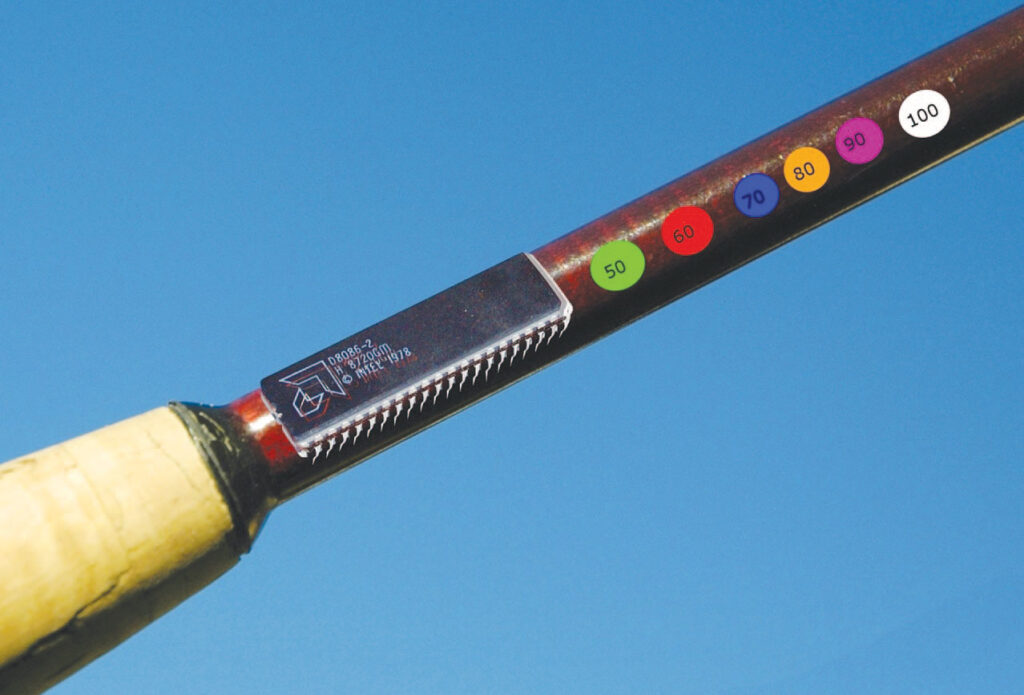
These guides feature a highly polished, low-friction ceramic ring fitted neatly inside a wire frame. The theory is that you cast farther with these guides because they cause less friction when the line comes in contact with the smooth ceramic insert. It certainly sounds plausible, doesn’t it? What’s more, it doesn’t cost a lot to put a new set of guides on a rod. If you are good with your hands, replacing guides is pretty simple. Even if you select the more exotic ceramic guides, the DIY approach will cost you only about $70. A custom builder can probably do it for about $150. That’s peanuts, compared with the cost of a new rod.
I do not doubt that these guides produce less line friction than normal wire guides. The question is whether this makes any difference in the real world. I am afraid I have not been able to substantiate these distance claims. In fact, the ceramic guides I have tested actually reduced distance. The problem is that ceramic guides weigh more than regular wire guides. That extra mass on the slender tip sections of the rod causes more counterflex at the end of the casting stroke. The rod tip wags up and down as the line exits the tip, sending the line on a wavy, snakelike path toward its intended target. The ideal path for a fly line is straight. Any deviation from this is wasted energy and will result in shorter casts. Given the pace of technology, I am willing to bet that someone will eventually produce a ceramic guide that is as light as the finest wire guides or a wire guide with a harder, slicker finish. When that happens, we might finally see a distance benefit from these guides. Until then, I will stick with wire guides on my rods.
Larger Guides
Another frequently made claim is that larger guides are better for distance casting. Folks making this argument say the wider opening provided by the larger guide means that the fly line is less likely to contact the guide as it shoots out. Less contact means less friction, ergo more distance. Being made of wire, these guides don’t weigh much more than standard guides, so the effect on rod-tip oscillation is usually not significant.
I tested the wide-guide theory on two rods a few years back. Sadly, in neither case did the increased diameter result in any measurable increase in distance when compared with regular guides. There is one advantage these guides do provide, which may make them worth using. The larger opening does allow the occasional fly-line tangle to exit the rod a little more easily. Anyone who has hooked a hot fish only to watch a line snarl leap up and wedge in the guides will understand the benefit of a few extra millimeters of guide diameter. On the other hand, some observers say it’s easier to wrap shooting line around the outside of a large snake on a cast or when a hot fish runs than around a smaller one.
An Extra Stripper
Another interesting idea that has been around for a while is that you can add distance by wrapping an extra stripping guide three or four inches above the butt guide. According to the proponents of this approach, the extra guide helps funnel the fly line more effectively into the rest of the guides, thereby reducing line friction. Anyone who has watched a fly line enter the stripping guides during casting has probably noticed it doesn’t always go in smoothly. When I am really casting far and fast, I often see the line shoot several inches beyond the butt guide before reversing course and squiggling into the guide. Testing the theory of an additional guide is easy enough. Simply tape an additional butt guide a few inches above the existing one and go casting. I did this with two rods and cast them with weight-forward lines and shooting heads. Sad to say, the results were disappointing. I got no extra distance from the additional guide. While I could see no benefit, you might. The small cost of the extra guide could make this a cheap way to add a few feet. If not, you will still have a spare guide.
We all dream about the day when we make a perfect long cast and connect with something large and furious. It’s possible that by paying a little more attention to your rod, you might be able to make that a reality, but my testing suggests that today’s rods are pretty good at distance casting as is. A more likely place to look for more distance from you casts is in the mirror. It’s the biological system attached to the rod, after all, that makes the cast happen.



